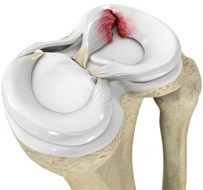MENISCUS TEAR
Meniscus tear
Meniscus tear is the commonest knee injury in athletes, especially those involved in contact sports.
The meniscus consists of two wedge-shaped pieces of cartilage located between the thighbone (femur) and the shinbone (tibia). These pieces of cartilage serve to:
- Stabilize the knee joint
- Act as shock absorbers

- Causes of Meniscus Tears
- Symptoms of a Torn Meniscus
- Diagnosis
Traumatic Meniscus Tears
A meniscus tear often occurs due to a sudden bend or twist in the knee, particularly during physical activities that involve pivoting or sudden stops. This type of injury is referred to as a traumatic meniscus tear and is prevalent among athletes.
Degenerative Meniscus Tears
Elderly individuals are more prone to degenerative meniscus tears. As cartilage wears out and weakens with age, the meniscus becomes more susceptible to tears even with minimal stress.
A torn meniscus can result in several symptoms, including:
- Pain
- Swelling
- Stiffness
- Catching or locking sensation in the knee
- Inability to move the knee through its complete range of motion
To diagnose a meniscus tear, an orthopedic surgeon will:
- Evaluate your symptoms
- Examine your knee
- Request radiological investigations such as X-ray and MRI
TREATMENT OPTIONS
The treatment plan for a torn meniscus depends on several factors, including the type, size, and location of the tear, as well as the patient’s age and activity level.
Non-Surgical Treatment
Initially, non-surgical treatment is appropriate. In some circumstances, for instance with a degenerative tear, there may be natural resolution, and this treatment may become the definitive one. It will be important to actively rehabilitate the injury however. This can be provided by our expert physiotherapists.
- Rest
- Ice
- Compression
- Elevation
- Physical therapy
Surgical Treatment
- Knee Arthroscopy
- Meniscectomy
- Meniscus Repair
Knee arthroscopy is a commonly recommended surgical procedure for meniscal tears. It involves inserting a tiny camera (arthroscope) through a small incision to view the inside of the knee. The surgeon can then perform the surgery through additional small incisions.
During a meniscectomy, small instruments like shavers or scissors are used to remove damaged parts of the torn meniscus. This procedure is often chosen when the tear is in a part of the meniscus that is of poor quality, or lacks sufficient blood supply for healing.
In an arthroscopic meniscus repair, the torn meniscus is stitched. Multiple factors determine when a meniscus repair is indicated, but generally it is performed in young patients, and in older patients when the quality and blood supply of the meniscal tissue is favourable, both of which facilitate healing. The decision to repair a meniscus will commit the patient to a period of time without placing weight through the limb, and therefore requiring the use of crutches.











